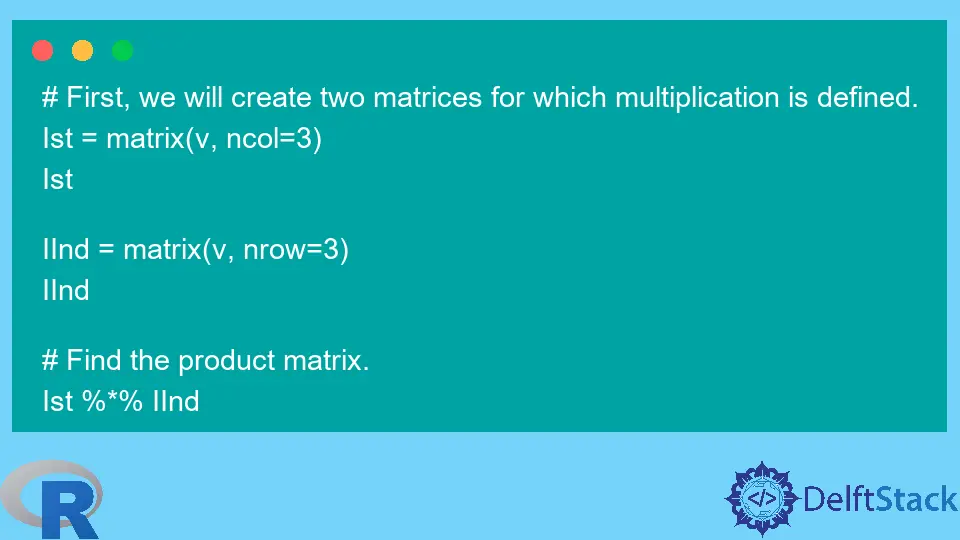在 R 中使用 %*% 運算子
Jesse John
2023年1月30日
R
R Matrix
R Operator

%*% 運算子用於矩陣乘法。在相同長度的向量中,此運算子給出點積。
在本文中,我們將通過一些簡單的示例來探索該運算子的使用。
R 中的矩陣及其維數
矩陣是數字的矩形陣列。它就像一個數字表,有行和列。
以下程式碼使用相同的 12 個數字建立並顯示四個矩陣。
示例程式碼:
# First, we will create a vector of numbers.
# These 12 numbers are what we will place in our matrices.
v = 7:18
# Matrix with 2 rows and 6 columns.
matrix(v, nrow=2)
dim(matrix(v, nrow=2))
# Matrix with 3 rows and 4 columns.
matrix(v, nrow=3)
dim(matrix(v, nrow=3))
# Matrix with 4 rows and 3 columns.
matrix(v, nrow=4)
dim(matrix(v, nrow=4))
# Matrix with 6 rows and 2 columns.
matrix(v, nrow=6)
dim(matrix(v, nrow=6))
輸出:
> # Matrix with 2 rows and 6 columns.
> matrix(v, nrow=2)
[,1] [,2] [,3] [,4] [,5] [,6]
[1,] 7 9 11 13 15 17
[2,] 8 10 12 14 16 18
> dim(matrix(v, nrow=2))
[1] 2 6
> # Matrix with 3 rows and 4 columns.
> matrix(v, nrow=3)
[,1] [,2] [,3] [,4]
[1,] 7 10 13 16
[2,] 8 11 14 17
[3,] 9 12 15 18
> dim(matrix(v, nrow=3))
[1] 3 4
> # Matrix with 4 rows and 3 columns.
> matrix(v, nrow=4)
[,1] [,2] [,3]
[1,] 7 11 15
[2,] 8 12 16
[3,] 9 13 17
[4,] 10 14 18
> dim(matrix(v, nrow=4))
[1] 4 3
> # Matrix with 6 rows and 2 columns.
> matrix(v, nrow=6)
[,1] [,2]
[1,] 7 13
[2,] 8 14
[3,] 9 15
[4,] 10 16
[5,] 11 17
[6,] 12 18
> dim(matrix(v, nrow=6))
[1] 6 2
我們在上面建立的每個矩陣都有不同的行數和列數。
矩陣由其行數和列數描述;這稱為它的維度。具有 m 行和 n 列的矩陣稱為 m x n 矩陣,讀作 m × n。
我們建立的矩陣具有以下尺寸:2x6、3x4、4x3 和 6x2。
使用 %*% 運算子在 R 中將矩陣相乘
僅當第一個矩陣的列數等於第二個矩陣的行數時才定義矩陣乘法。當滿足這個條件時,我們可以使用 %*% 運算子按順序將這兩個矩陣相乘,並且乘積也是一個矩陣。
乘積矩陣的行數與第一個矩陣一樣多,列數與第二個矩陣一樣多。
示例程式碼:
# First, we will create two matrices for which multiplication is defined.
Ist = matrix(v, ncol=3)
Ist
IInd = matrix(v, nrow=3)
IInd
# Find the product matrix.
Ist %*% IInd
輸出:
> # First, we will create two matrices for which multiplication is defined.
> Ist = matrix(v, ncol=3)
> Ist
[,1] [,2] [,3]
[1,] 7 11 15
[2,] 8 12 16
[3,] 9 13 17
[4,] 10 14 18
> IInd = matrix(v, nrow=3)
> IInd
[,1] [,2] [,3] [,4]
[1,] 7 10 13 16
[2,] 8 11 14 17
[3,] 9 12 15 18
> # Find the product matrix.
> Ist %*% IInd
[,1] [,2] [,3] [,4]
[1,] 272 371 470 569
[2,] 296 404 512 620
[3,] 320 437 554 671
[4,] 344 470 596 722
我們將看另一個有效矩陣乘法的示例和兩個未定義矩陣乘法的示例。
示例程式碼:
# A 3 x 2 matrix.
IInd_b = matrix(20:25, nrow=3)
IInd_b
# A 2 x 6 matrix.
Ist_b = matrix(v, nrow=2)
Ist_b
# Matrix multiplication is defined between Ist and IInd_b.
Ist %*% IInd_b
# Multiplication is NOT defined in the following two cases.
IInd_b %*% Ist
Ist_b %*% IInd_b
輸出:
> # A 3 x 2 matrix.
> IInd_b = matrix(20:25, nrow=3)
> IInd_b
[,1] [,2]
[1,] 20 23
[2,] 21 24
[3,] 22 25
> # A 2 x 6 matrix.
> Ist_b = matrix(v, nrow=2)
> Ist_b
[,1] [,2] [,3] [,4] [,5] [,6]
[1,] 7 9 11 13 15 17
[2,] 8 10 12 14 16 18
> # Matrix multiplication is defined between Ist and IInd_b.
> Ist %*% IInd_b
[,1] [,2]
[1,] 701 800
[2,] 764 872
[3,] 827 944
[4,] 890 1016
> # Multiplication is NOT defined in the following two cases.
> IInd_b %*% Ist
Error in IInd_b %*% Ist : non-conformable arguments
> Ist_b %*% IInd_b
Error in Ist_b %*% IInd_b : non-conformable arguments
使用 %*% 運算子獲取 R 中向量的點積
向量由它們的長度和類別(和型別)來描述。
示例程式碼:
# Create a vector.
vtr = c(11,22,33)
# Check that it is a vector.
is.vector(vtr)
# Length of the vector.
length(vtr)
# Class of the vector.
class(vtr)
# Type of the vector.
typeof(vtr)
輸出:
> # Create a vector.
> vtr = c(11,22,33)
> # Check that it is a vector.
> is.vector(vtr)
[1] TRUE
> # Length of the vector.
> length(vtr)
[1] 3
> # Class of the vector.
> class(vtr)
[1] "numeric"
> # Type of the vector.
> typeof(vtr)
[1] "double"
向量的長度是其中元素(數字)的數量。
當我們使用 %*% 運算子將兩個相同長度的向量相乘時,我們得到向量的點積。R 隱含地將第一個向量視為行矩陣,將第二個向量視為列矩陣,併為我們提供乘積矩陣。
它返回一個 1x1 矩陣而不是一個標量。我們可以使用 is.vector() 和 is.matrix() 函式來驗證這一點。
在下面的程式碼中,我們將首先獲得兩個相同長度的向量之間的點積。然後,我們將使用一致維度的矩陣得到相同的結果。
示例程式碼:
# Four-element vectors.
V_I = 22:25
V_II = 2:5
# Dot product of vectors of the same dimension.
V_I %*% V_II
# Check the input and output.
is.vector(V_I)
is.matrix(V_I)
is.vector(V_I %*% V_II)
is.matrix(V_I %*% V_II)
# Create matrices of conformable dimensions (where matrix multiplication is defined).
m_I = matrix(V_I, nrow=1)
m_I
m_II = matrix(V_II, ncol=1)
m_II
# Matrix product.
m_I %*% m_II
輸出:
> # Four-element vectors.
> V_I = 22:25
> V_II = 2:5
> # Dot product of vectors of the same dimension.
> V_I %*% V_II
[,1]
[1,] 334
> # Check the input and output.
> is.vector(V_I)
[1] TRUE
> is.matrix(V_I)
[1] FALSE
> is.vector(V_I %*% V_II)
[1] FALSE
> is.matrix(V_I %*% V_II)
[1] TRUE
> # Create matrices of conformable dimensions (where matrix multiplication is defined).
> m_I = matrix(V_I, nrow=1)
> m_I
[,1] [,2] [,3] [,4]
[1,] 22 23 24 25
> m_II = matrix(V_II, ncol=1)
> m_II
[,1]
[1,] 2
[2,] 3
[3,] 4
[4,] 5
> # Matrix product.
> m_I %*% m_II
[,1]
[1,] 334
如果向量的長度不同,我們就無法計算點積。
示例程式碼:
# A three-element vector.
V_II_b = 6:8
# Dot product is not possible.
V_I %*% V_II_b
輸出:
> # A three-element vector.
> V_II_b = 6:8
> # Dot product is not possible.
> V_I %*% V_II_b
Error in V_I %*% V_II_b : non-conformable arguments
まとめ
對於乘法的一致矩陣,%*% 返回乘積矩陣。對於相同長度的向量,它將點積作為 1x1 矩陣返回。
Enjoying our tutorials? Subscribe to DelftStack on YouTube to support us in creating more high-quality video guides. Subscribe
作者: Jesse John
